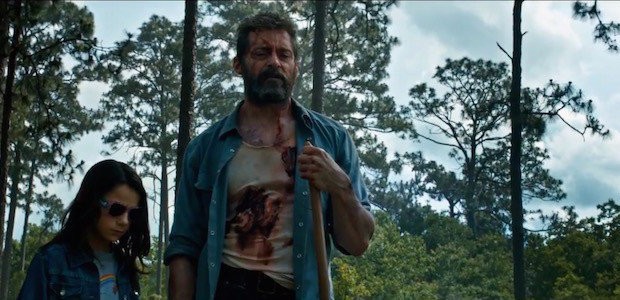LOGAN, a hard R-rated film featuring a beloved comic book property traditionally aimed at children, has been getting high critical praise and raking in tons of money at the box office. As is tradition in Hollywood, other studios will chase the success of LOGAN and try to replicate films that can sponge off its winning formula. The problem is that whenever producers do this, it tends to be a superficial understanding of what made the film popular. For example, people may think that just because the movie had swears and (lots of) bloody violence, that’s what made people connect so well with it. So, in the glow of LOGAN‘s triumph at the cineplex, it’s time to outline the right lessons that filmmakers can learn from James Mangold’s movie, and how to apply it to future endeavors.
Firstly, to get it out of the way early, LOGAN didn’t succeed because it was R-rated. Yes, DEADPOOL paved the way and bolstered Fox Studios into believing that money could be made from R-rated comic book fare. So while producers may have learned that an R rating isn’t a turnoff, they still managed to put out a film that works on multiple levels and is an engaging character portrait with naughty words and visceral action sequences. And while people have been clamoring for a more “mature” (in this context, when people say “mature” they usually mean graphically violent, unfortunately) take on Wolverine since his debut in Bryan Singer’s X-MEN, that wasn’t enough to sell it completely. The fact is that the adult language and intense action are completely logical extensions to the character—a man bred to be a weapon, with pain and regret at all he has witnessed and encountered in his life, wrestling with his role and penchant for violence. Mangold’s film is a natural progression for a character that people have gotten to know quite well over eight previous films. There will be many insiders who think that every comic book film needs to be injected with this ultraviolence or strive for a hard R to capture some of LOGAN’s heat, but they would be shortsighted.
The R rating enabled Mangold (and his fellow collaborators) to tell a more adult-themed story, but it was a completely character-based decision. The themes of the film are actually mature—and not just “mature” by aping darker elements—with a man facing mortality and a world passing him by, while still wrestling with his past and his responsibilities. Even though LOGAN features SHANE in it, the film closer to Clint Eastwood’s UNFORGIVEN: a meditation on an aging man who was born in violence that realizes that his curse may be the closest thing to a gift he can bring to people who need him. So when telling that story, based on years of cultivating character, it makes sense that the internal struggle is realized in an explicit and adult fashion.
Similarly, DEADPOOL is an irreverent undercutting of superhero tropes aimed at people old enough to get the subversion. At the same time, the playfulness of DEADPOOL isn’t mature—sex and dick and fart jokes wouldn’t necessarily be called “adult”—but the way the character delves in to those asides and digressions is perfectly fitting with the character from the comics. So while DEADPOOL was also an R-rated success, it’s not because the majority of people said “Finally! A spandex film with cursing in it!” but instead responded to the core premise and promise of the character to be a juvenile take down of familiar elements in previous movies.
And so the real lesson that LOGAN (and DEADPOOL) should teach Hollywood isn’t that people desperately want graphic violence and cussing from their heroes, or that things need to move into the faux-mature world of dark’n’gritty (as seen in many comics in the ’90s, especially at Image), but that people want original stories that build on what inherently works for that character. People don’t need a (or another) FANTASTIC FOUR movie with horrific violence and unnecessarily grim stakes; it actually would probably work best as a vehicle aimed for younger audiences, with its emphasis on family and showcasing crazy inventions and superscience (for those that doubt it, check out the success of THE INCREDIBLES). Expand on the visual acumen of DOCTOR STRANGE in its sequel by fully embracing its gonzo aesthetics to produce something closer to a Refn film or some other art house palette that feels psychedelic minus actually taking drugs.
Filmmakers need to distill what has resonated with these characters for years. Directors need to be able to tap into what has appealed about the stories told around these popular characters for decades, and then expand on that—maybe into R-rated territory, but usually that’s not needed. One of the (many) big misfires of BATMAN V SUPERMAN: DAWN OF JUSTICE is that it misunderstands the appeal of Superman, as a real embodiment of hope and possibility through his words and deeds. Audiences don’t need another grimdark figure in a cape, what they need is the Superman they love. And studios need to let the filmmakers experiment and expand the concept of what a writer and director can do with a comic book property (one of the hobbling aspects of Marvel Studios’ otherwise winning system). Warner Bros., Fox, and Disney/Marvel need to take on each property at its own face value and recognize what that particular story needs in terms of ratings, in terms of delivering emotional beats, and in terms of furthering the idea of a character that has resonated with so many for so long. LOGAN‘s critical and financial success isn’t just a kneejerk reaction to being mature, but an appreciation for a great story that highlights a terrific understanding of a character.
Tags: Boyd Holbrook, Dafne Keen, Elise Neal, Elizabeth Rodriguez, Eriq La Salle, James Mangold, John Mathieson, John Romita Sr., Len Wein, Michael Green, Patrick Stewart, Richard E. Grant, Roy Thomas, Scott Frank, Stephen Merchant


No Comments